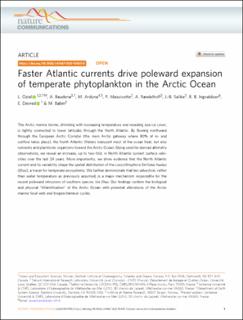Faster Atlantic currents drive poleward expansion of temperate phytoplankton in the Arctic Ocean
| dc.contributor.author | Oziel, L. | |
| dc.contributor.author | Baudena, A. | |
| dc.contributor.author | Ardyna, M. | |
| dc.contributor.author | Massicotte, Philippe | |
| dc.contributor.author | Randelhoff, Achim | |
| dc.contributor.author | Sallée, Jean-Bapiste | |
| dc.contributor.author | Ingvaldsen, Randi Brunvær | |
| dc.contributor.author | Devred, E. | |
| dc.contributor.author | Babin, Marcel | |
| dc.date.accessioned | 2021-01-14T11:56:35Z | |
| dc.date.available | 2021-01-14T11:56:35Z | |
| dc.date.created | 2020-12-09T17:44:02Z | |
| dc.date.issued | 2020 | |
| dc.identifier.citation | Nature Communications. 2020, 11 (1), 1-8. | en_US |
| dc.identifier.issn | 2041-1723 | |
| dc.identifier.uri | https://hdl.handle.net/11250/2723059 | |
| dc.description.abstract | The Arctic marine biome, shrinking with increasing temperature and receding sea-ice cover, is tightly connected to lower latitudes through the North Atlantic. By flowing northward through the European Arctic Corridor (the main Arctic gateway where 80% of in- and outflow takes place), the North Atlantic Waters transport most of the ocean heat, but also nutrients and planktonic organisms toward the Arctic Ocean. Using satellite-derived altimetry observations, we reveal an increase, up to two-fold, in North Atlantic current surface velocities over the last 24 years. More importantly, we show evidence that the North Atlantic current and its variability shape the spatial distribution of the coccolithophore Emiliania huxleyi (Ehux), a tracer for temperate ecosystems. We further demonstrate that bio-advection, rather than water temperature as previously assumed, is a major mechanism responsible for the recent poleward intrusions of southern species like Ehux. Our findings confirm the biological and physical “Atlantification” of the Arctic Ocean with potential alterations of the Arctic marine food web and biogeochemical cycles. | en_US |
| dc.language.iso | eng | en_US |
| dc.title | Faster Atlantic currents drive poleward expansion of temperate phytoplankton in the Arctic Ocean | en_US |
| dc.type | Peer reviewed | en_US |
| dc.type | Journal article | en_US |
| dc.description.version | publishedVersion | en_US |
| dc.source.pagenumber | 1-8 | en_US |
| dc.source.volume | 11 | en_US |
| dc.source.journal | Nature Communications | en_US |
| dc.source.issue | 1 | en_US |
| dc.identifier.doi | 10.1038/s41467-020-15485-5 | |
| dc.identifier.cristin | 1858088 | |
| cristin.ispublished | true | |
| cristin.fulltext | original | |
| cristin.qualitycode | 2 |
Tilhørende fil(er)
Denne innførselen finnes i følgende samling(er)
-
Articles [3012]
-
Publikasjoner fra CRIStin [3066]
